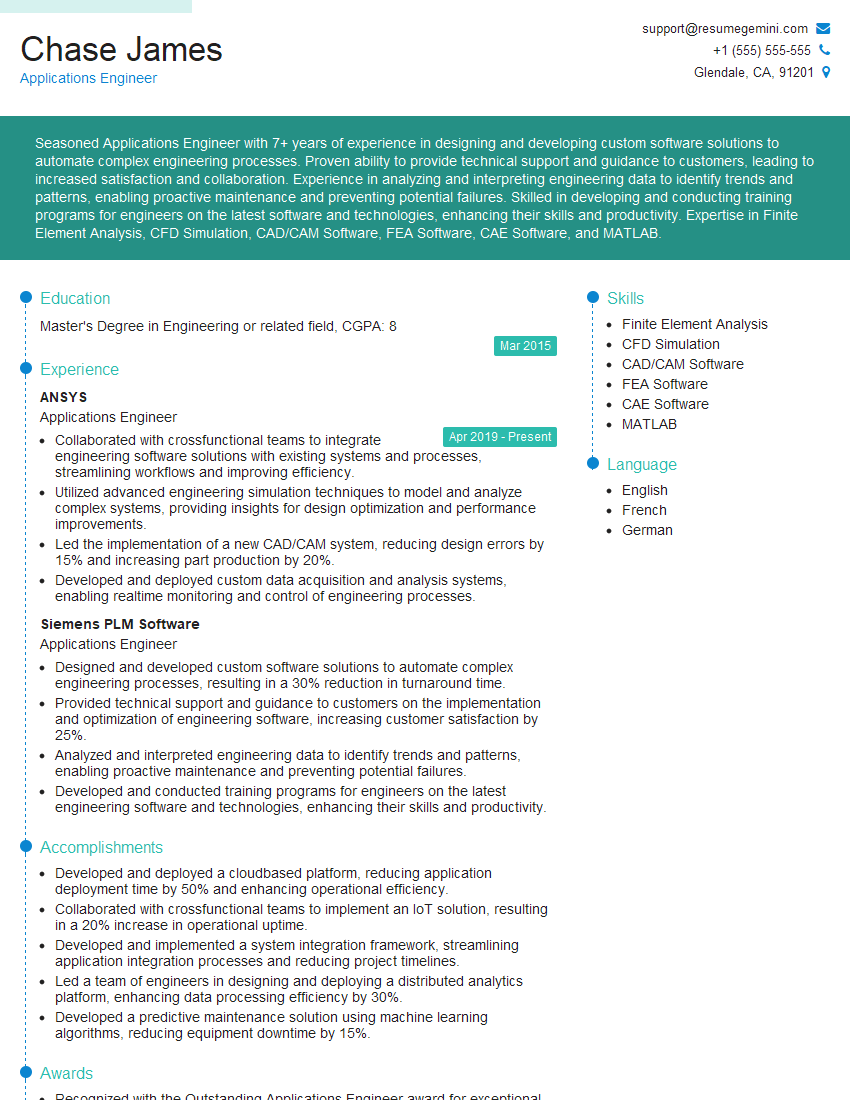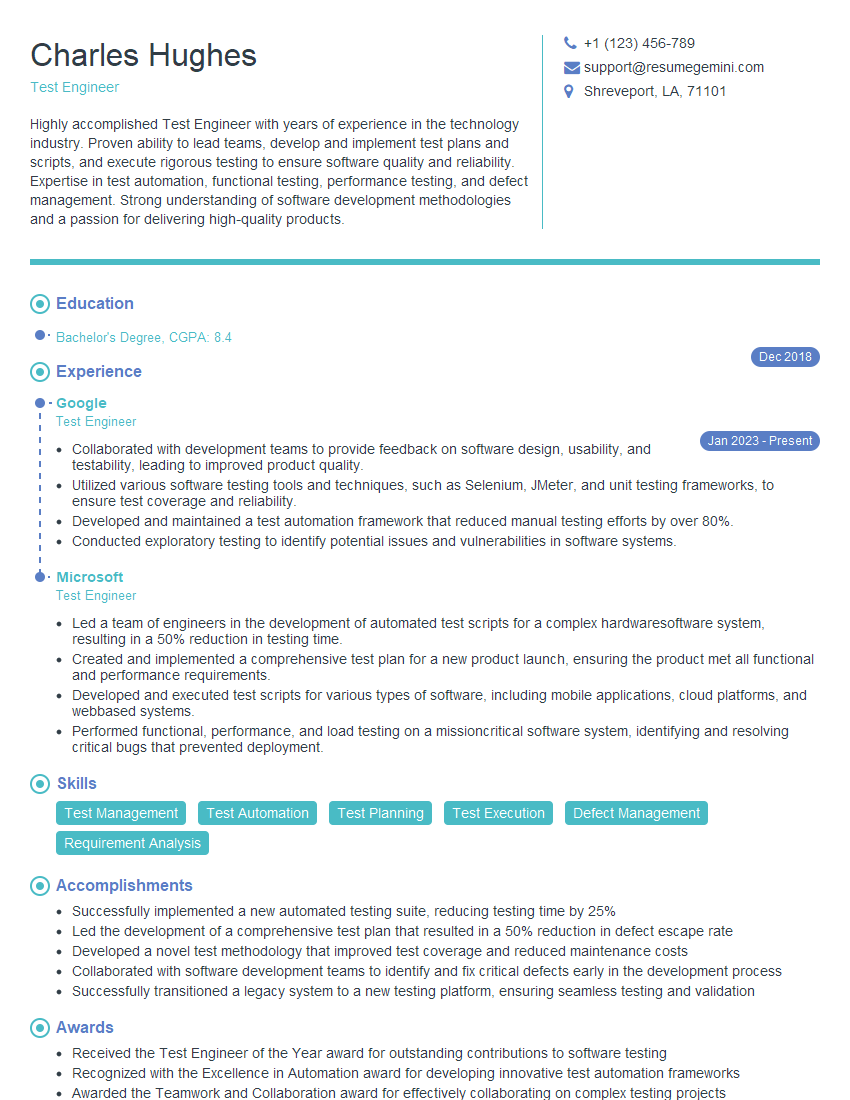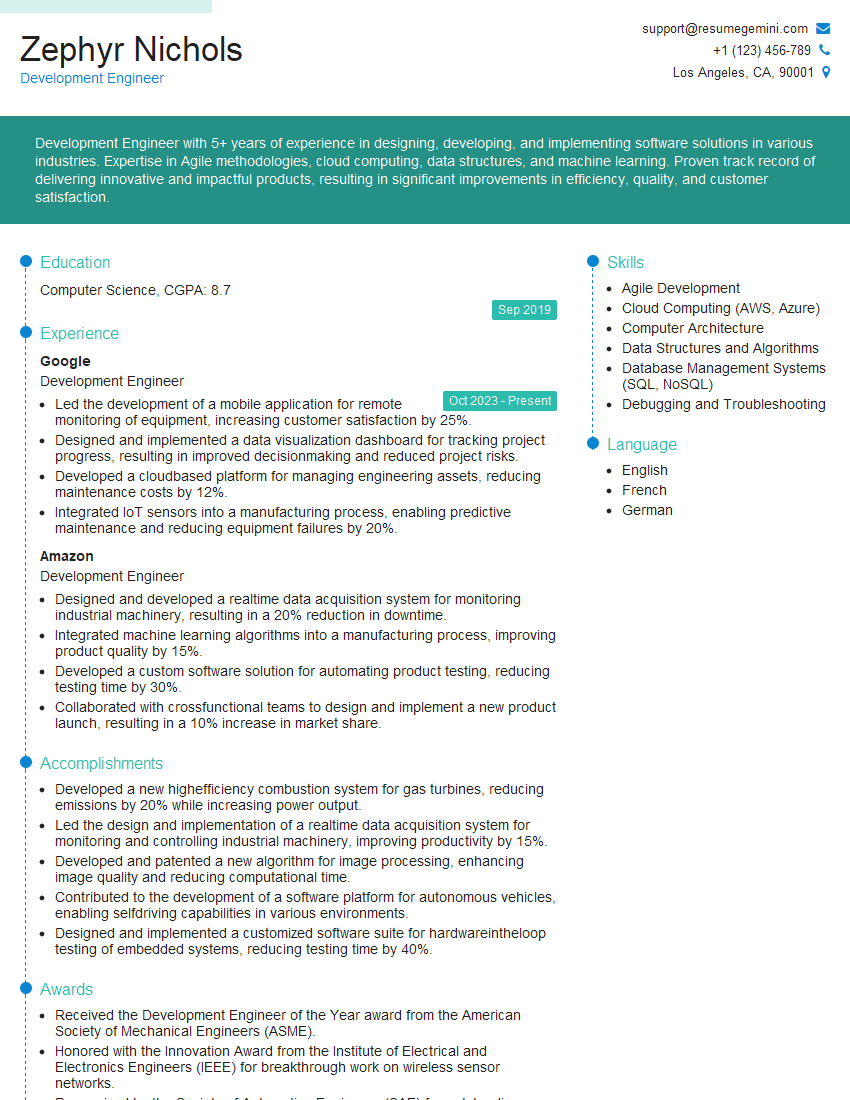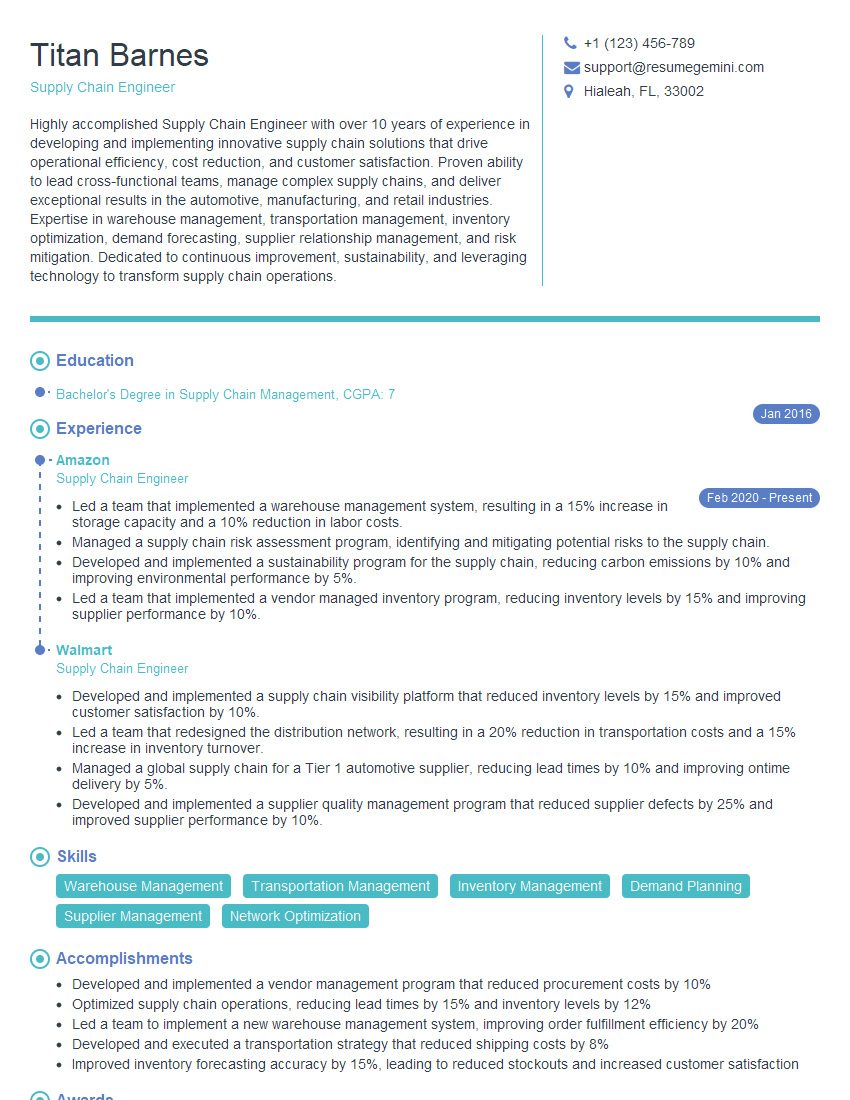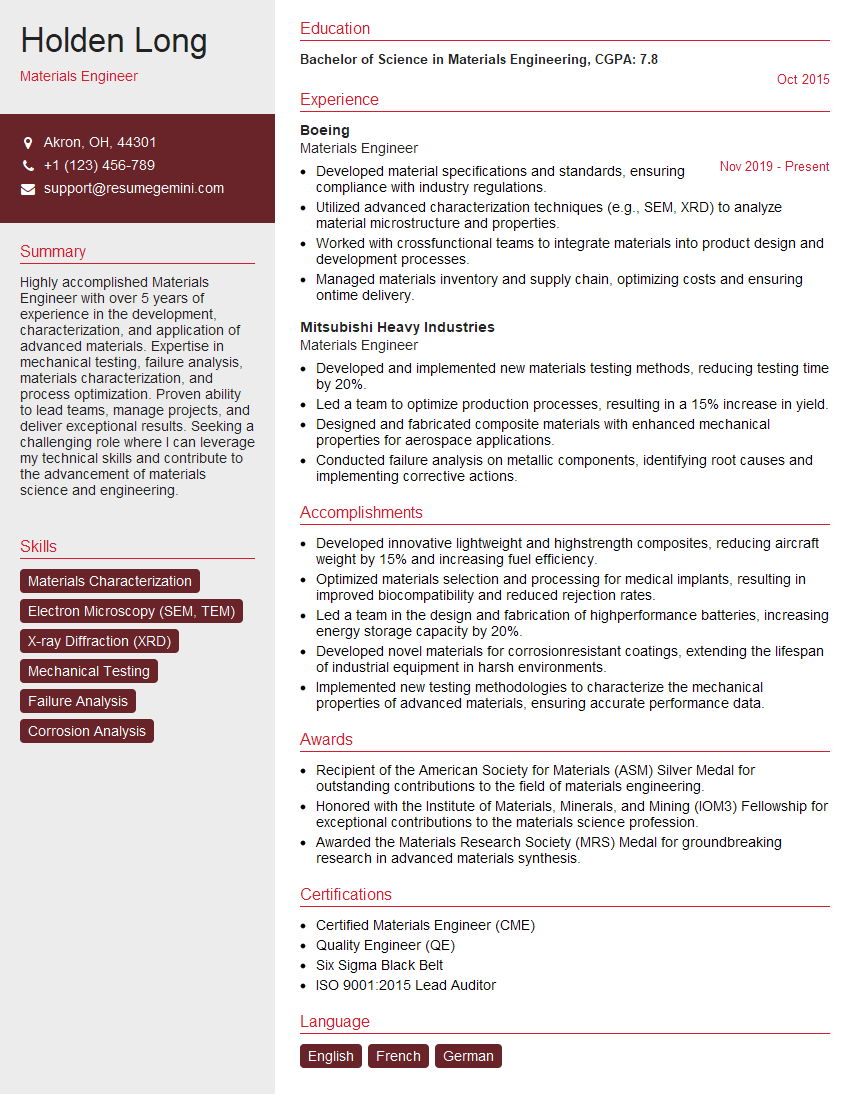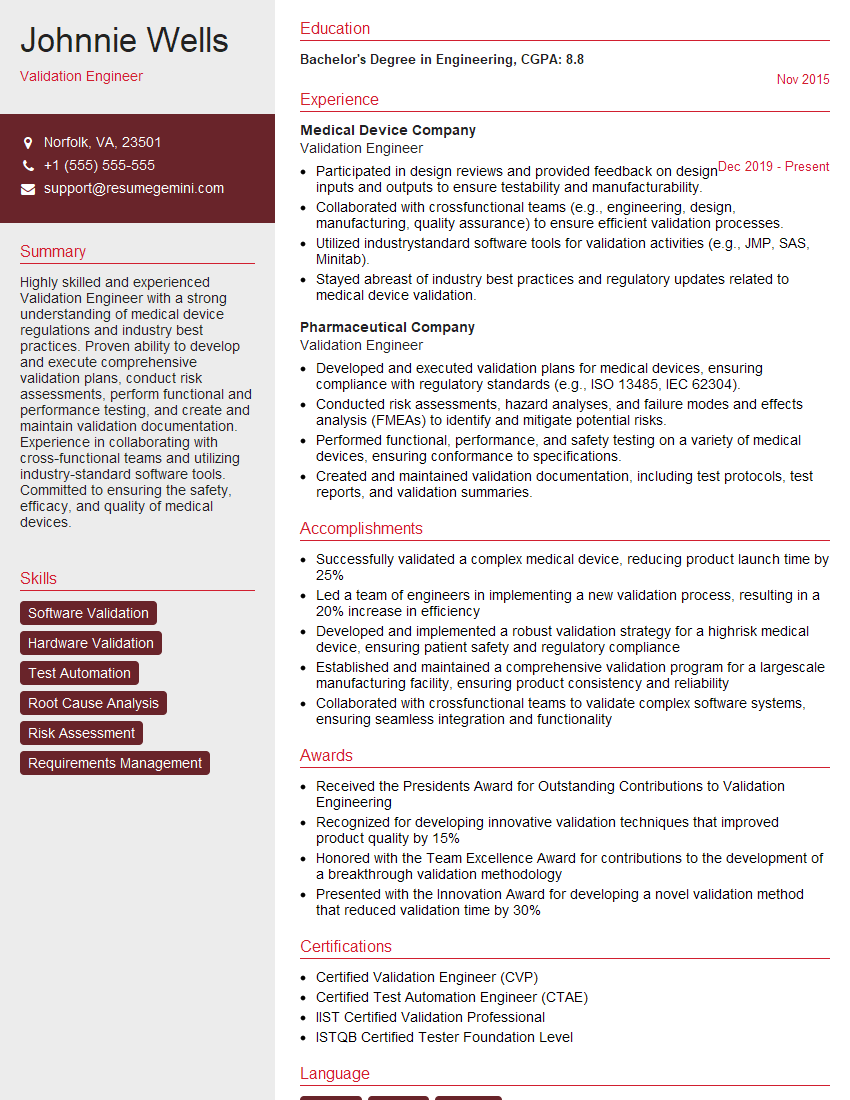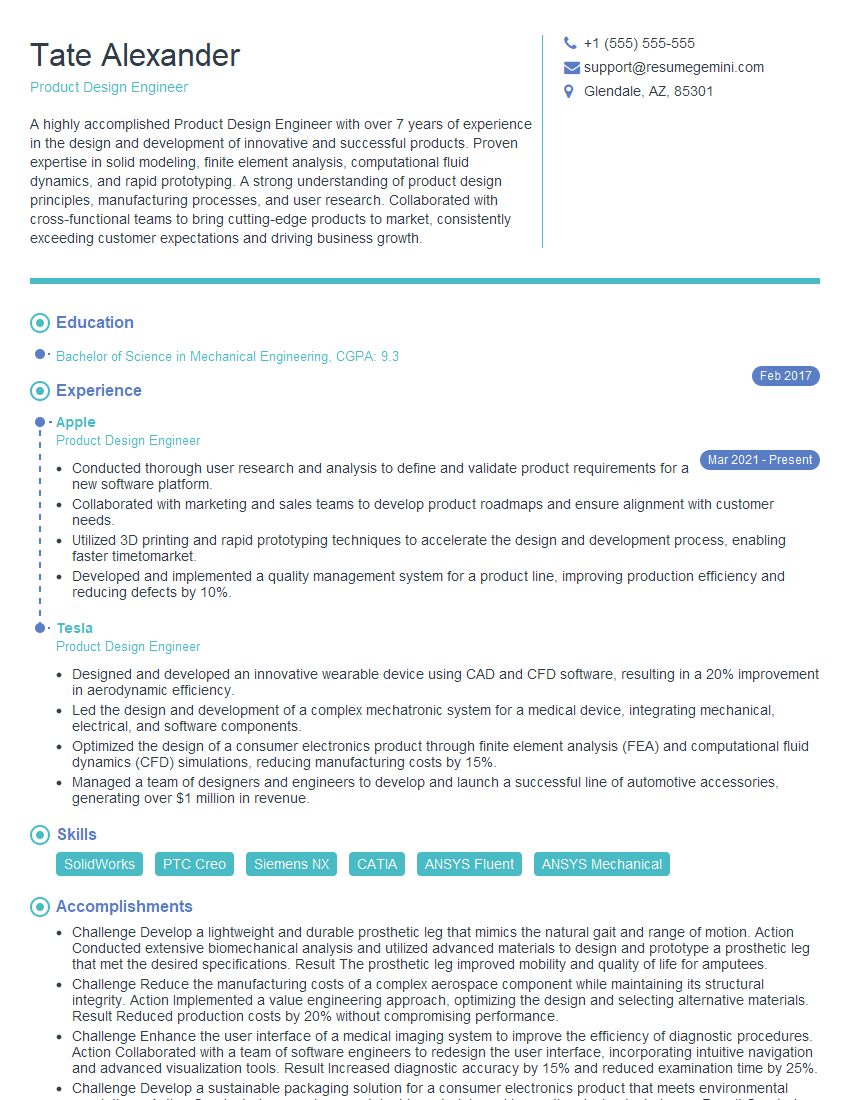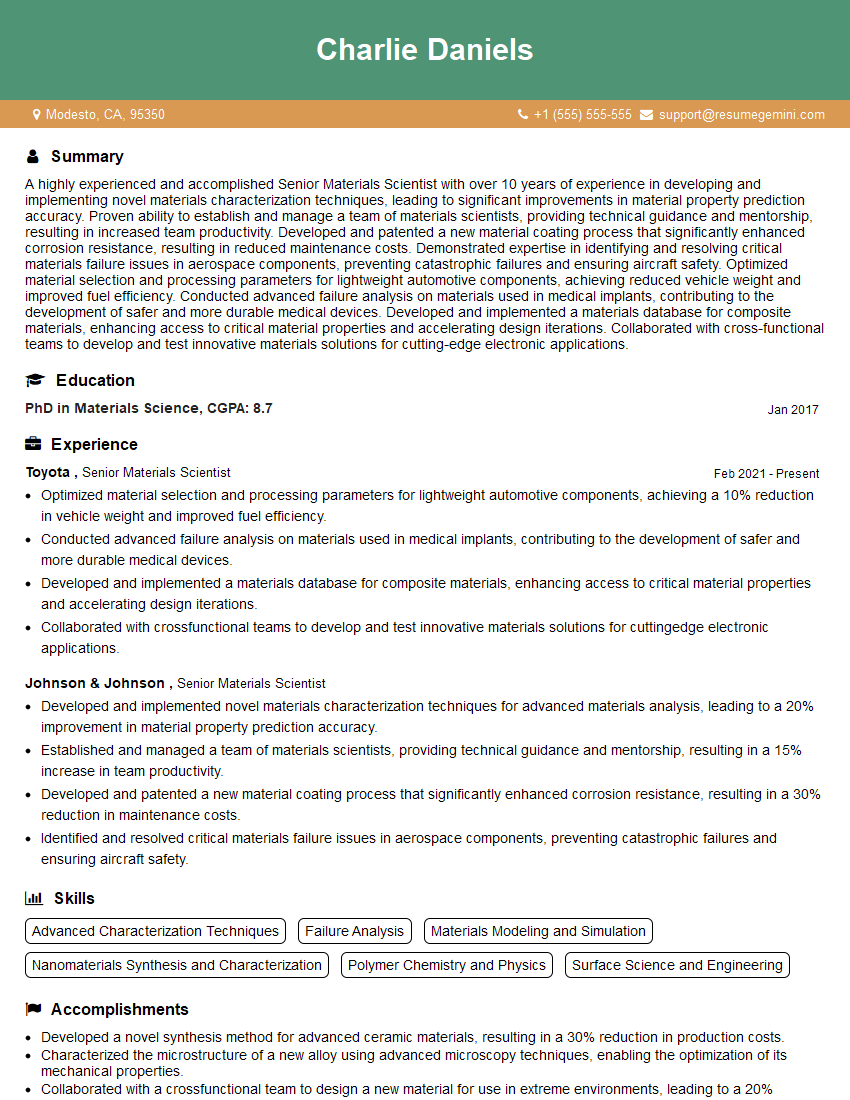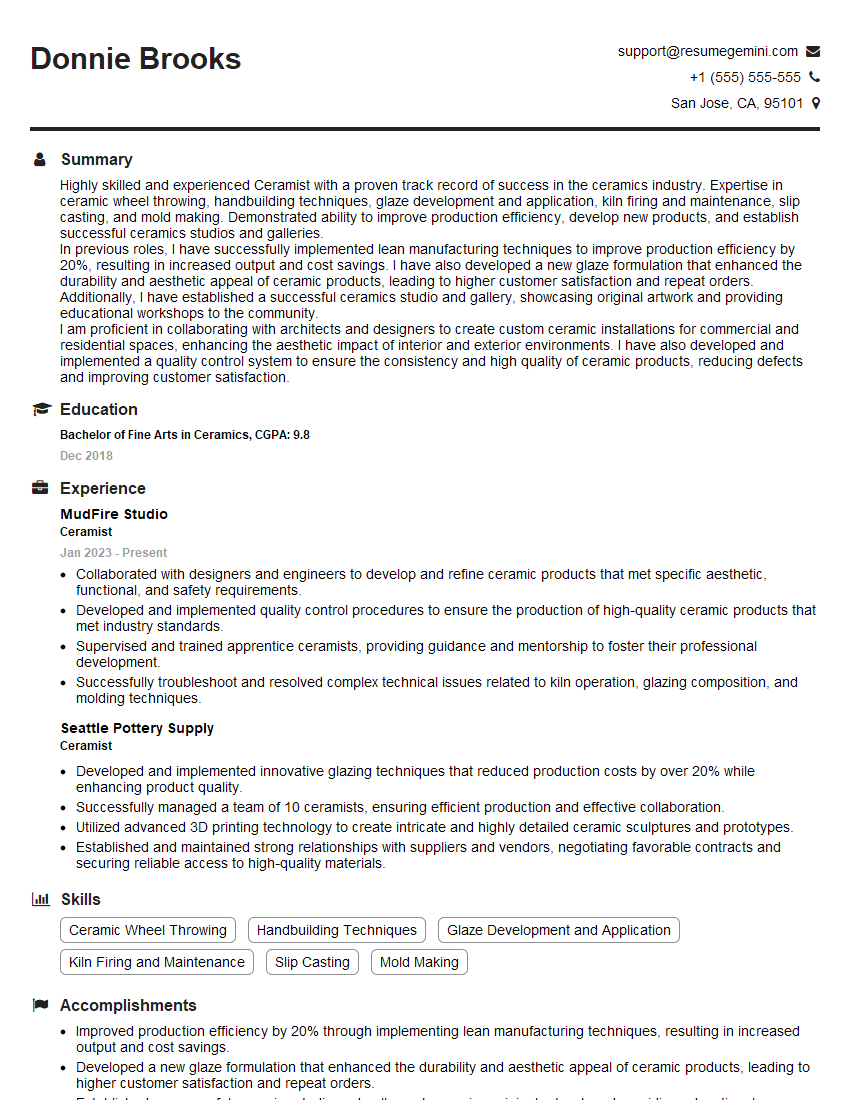Every successful interview starts with knowing what to expect. In this blog, we’ll take you through the top Materials and Hardware Selection interview questions, breaking them down with expert tips to help you deliver impactful answers. Step into your next interview fully prepared and ready to succeed.
Questions Asked in Materials and Hardware Selection Interview
Q 1. Explain the difference between tensile strength and yield strength.
Tensile strength and yield strength are both measures of a material’s resistance to deformation under tensile stress, but they represent different points on the material’s stress-strain curve. Tensile strength is the maximum stress a material can withstand before it fractures. Think of it like the ultimate breaking point. Yield strength, on the other hand, represents the stress at which the material begins to deform plastically – meaning the deformation is permanent and won’t recover once the load is removed. It’s the point where the material starts to yield or bend permanently.
Imagine stretching a rubber band. The tensile strength is the point where it snaps. The yield strength is the point where it stretches beyond its original length and doesn’t return to its original shape when you let go.
In engineering applications, knowing both values is crucial. You’d want a component to have a high tensile strength to prevent failure, but you’d also want a high yield strength to ensure the component doesn’t deform permanently under normal operating conditions.
Q 2. Describe the factors influencing the selection of a particular material for a specific application.
Material selection is a critical aspect of engineering design, influenced by a complex interplay of factors. The primary considerations include:
- Required Properties: This is the most important factor. What strength, stiffness, toughness, ductility, or other properties does the application demand? For instance, a bridge needs high tensile strength and fatigue resistance, while a flexible circuit board needs flexibility and electrical conductivity.
- Environmental Conditions: Will the material be exposed to high temperatures, corrosive chemicals, or radiation? The material must withstand these conditions without degradation or failure. For example, materials used in aerospace applications must withstand extreme temperatures and pressures.
- Manufacturing Processes: The chosen material must be compatible with the manufacturing processes used. Can it be easily cast, machined, welded, or formed? For example, using a material difficult to mold in mass production would significantly increase costs.
- Cost: Materials vary significantly in cost. The balance between performance and cost is often a key decision point. Sometimes a slightly more expensive, higher-performance material might be more cost-effective in the long run by reducing failure rates or extending lifespan.
- Availability and Sustainability: The material’s availability and its environmental impact are increasingly important factors. Using readily available and sustainable materials minimizes supply chain risks and promotes environmental responsibility.
The selection process often involves a trade-off between these different factors. A systematic approach, such as using decision matrices or Pugh charts, helps engineers to evaluate and prioritize the various options.
Q 3. What are the common failure modes of metallic components?
Metallic components can fail in various ways, often categorized as:
- Fracture: This is the complete separation of the material, caused by exceeding its tensile strength. This can be brittle (sudden, without much deformation) or ductile (with significant plastic deformation before fracture).
- Yielding: Permanent deformation occurs when the stress exceeds the yield strength. This can lead to unacceptable changes in component dimensions and functionality.
- Fatigue: Repeated cyclic loading can lead to crack initiation and propagation, even at stresses below the yield strength. This is a major cause of failure in many engineering components. Think of a repeatedly bending paperclip until it breaks.
- Creep: At high temperatures, sustained stress can cause slow, time-dependent deformation, even at stresses below the yield strength. This is a concern in high-temperature applications like gas turbines.
- Corrosion: Chemical or electrochemical reactions degrade the material, weakening it and making it susceptible to other failure modes.
- Wear: Surface damage caused by friction or abrasion. This is a common concern in moving parts of machinery.
Understanding these failure modes is essential for designing reliable and safe components. Proper material selection, design considerations, and preventative maintenance are crucial to avoid these failures.
Q 4. How do you select materials for high-temperature applications?
Selecting materials for high-temperature applications requires careful consideration of several properties. Key factors include:
- High Melting Point: The material should have a high melting point to maintain its structural integrity at elevated temperatures.
- High Creep Resistance: Creep resistance is crucial to prevent time-dependent deformation at high temperatures. Materials like superalloys are designed for this purpose.
- Oxidation Resistance: High temperatures often accelerate oxidation, leading to material degradation. Coatings or alloying additions can improve oxidation resistance.
- Thermal Shock Resistance: The material should be able to withstand rapid temperature changes without cracking or fracturing. Ceramic materials are often better suited to this than metals.
- Strength Retention at High Temperatures: The material must retain sufficient strength at the operating temperature to withstand the applied loads. Many high-temperature materials show a significant reduction in strength at elevated temperatures.
Examples of materials often used in high-temperature applications include nickel-based superalloys (e.g., Inconel, Hastelloy), refractory metals (e.g., molybdenum, tungsten), and advanced ceramics (e.g., silicon carbide, zirconia).
Q 5. Explain the concept of fatigue and creep in materials.
Fatigue and creep are time-dependent failure mechanisms that affect material performance under sustained or cyclic loading conditions.
Fatigue refers to the progressive and localized structural damage that occurs when a material is subjected to cyclic loading. Each cycle creates microscopic damage, eventually leading to crack initiation and propagation, and ultimately fracture, even at stress levels far below the material’s ultimate tensile strength. Think of repeatedly bending a wire – it eventually breaks, even if each bend is not enough to break it instantly.
Creep, on the other hand, is the time-dependent deformation of materials under constant stress, especially at elevated temperatures. The material slowly deforms over time, often leading to dimensional changes or failure. This is often observed in turbine blades in jet engines.
Understanding fatigue and creep is crucial in designing components for long-term service, especially under cyclic or high-temperature conditions. Appropriate material selection, design modifications, and preventative maintenance are necessary to mitigate these failure mechanisms.
Q 6. Discuss the trade-offs between material properties (strength, weight, cost).
Material selection often involves trade-offs between strength, weight, and cost. It’s rarely possible to optimize all three simultaneously.
- High Strength, High Weight, High Cost: Materials like titanium alloys offer exceptional strength and corrosion resistance but are heavy and expensive.
- High Strength, Low Weight, High Cost: Carbon fiber composites provide high strength-to-weight ratios, but their manufacturing cost is often high.
- High Strength, Low Weight, Low Cost: Achieving this combination is difficult. Aluminum alloys offer a reasonable balance, but their strength is lower than that of titanium or carbon fiber.
- Low Strength, Low Weight, Low Cost: Plastics and some aluminum alloys are light and inexpensive, but their strength is limited.
The optimal choice depends on the specific application and priorities. A lightweight aerospace component might justify the higher cost of titanium, while a less demanding application might opt for a cheaper, less strong alternative. Engineers often use material selection charts and optimization software to explore these trade-offs quantitatively.
Q 7. What are the advantages and disadvantages of using composites?
Composites are materials composed of two or more constituent materials with significantly different properties. They combine the advantages of each constituent to achieve a material with superior performance characteristics.
Advantages:
- High Strength-to-Weight Ratio: Composites often exhibit higher strength and stiffness per unit weight compared to traditional materials, making them ideal for aerospace and automotive applications.
- Tailorable Properties: The properties of a composite can be tailored by adjusting the type and proportion of its constituents and their arrangement.
- Corrosion Resistance: Many composites offer excellent corrosion resistance, extending their lifespan in harsh environments.
- Design Flexibility: Composites can be molded into complex shapes, allowing for innovative designs.
Disadvantages:
- High Manufacturing Cost: The manufacturing processes for composites are often more complex and expensive than those for traditional materials.
- Anisotropy: The properties of a composite can vary depending on the direction, making design and analysis more challenging.
- Damage Tolerance: Damage to composites can be difficult to detect and repair.
- Environmental Concerns: Some composite materials may pose environmental concerns during manufacturing or disposal.
Despite the disadvantages, the superior performance characteristics of composites continue to drive their increasing use in a wide range of applications.
Q 8. How do you determine the appropriate surface finish for a component?
Selecting the right surface finish is crucial for a component’s performance and lifespan. It’s not just about aesthetics; it impacts functionality, durability, and even cost. The process involves considering several factors:
- Functional Requirements: Does the component need to be highly resistant to corrosion (e.g., a marine application)? Will it experience significant friction (e.g., a bearing)? Or is it primarily for cosmetic purposes?
- Manufacturing Process: Some surface finishes are more easily achieved with certain manufacturing methods. For example, a highly polished finish might be expensive to achieve on a cast component compared to a machined one.
- Material Properties: The material itself dictates the achievable surface finishes. A brittle material might be prone to cracking under certain finishing processes.
- Cost Considerations: Different finishes have varying costs associated with them. Electroplating is typically more expensive than powder coating.
Example: Consider a medical implant. A highly polished, biocompatible surface finish is critical to minimize tissue rejection. Conversely, a roughened surface might be desirable for a high-friction component like a brake pad.
Step-by-step approach:
- Define the component’s function and operating environment.
- Identify potential surface finishes that meet these requirements.
- Evaluate the manufacturing feasibility and cost of each finish.
- Select the optimal finish based on a balance of functionality, cost, and manufacturability.
Q 9. Explain the importance of material compatibility in design.
Material compatibility is paramount in design; it refers to the ability of different materials to coexist without adverse reactions. Ignoring this can lead to catastrophic failures. Consider these aspects:
- Chemical Compatibility: Materials shouldn’t react chemically, causing corrosion, degradation, or the release of harmful substances. For example, using aluminum in contact with certain acids can lead to significant corrosion.
- Thermal Compatibility: Different materials have different thermal expansion coefficients. If mismatched, thermal stress can lead to cracking or warping, especially in applications with fluctuating temperatures.
- Mechanical Compatibility: Materials should have compatible mechanical properties to avoid issues like stress concentrations or galling (surface damage due to friction).
- Electrical Compatibility: In electrical applications, materials must be compatible to prevent short circuits, arcing, or unwanted electrical conductivity.
Example: In a fuel system, the materials must be compatible with the fuel to prevent leaks or degradation. Using incompatible materials in a battery could lead to short circuits and fires.
Ensuring Compatibility: Consult material compatibility charts, conduct testing (e.g., electrochemical tests, thermal cycling), and utilize FEA simulations to predict behavior.
Q 10. What are some common material testing methods?
Material testing is crucial for validating material properties and ensuring component reliability. Common methods include:
- Tensile Testing: Measures strength, ductility, and elasticity by pulling a specimen until failure.
- Compression Testing: Measures a material’s resistance to compressive forces.
- Fatigue Testing: Evaluates a material’s ability to withstand repeated loading cycles.
- Impact Testing: Assesses the material’s resistance to sudden impact forces (e.g., Charpy test).
- Hardness Testing: Determines a material’s resistance to indentation (e.g., Rockwell, Brinell tests).
- Corrosion Testing: Evaluates a material’s resistance to corrosion in different environments.
- Creep Testing: Measures a material’s deformation under sustained stress at high temperatures.
Example: A tensile test would be crucial for determining the yield strength of a structural component, ensuring it won’t deform under load. Fatigue testing is vital for components experiencing cyclical loading, such as those in aircraft engines.
Q 11. Describe your experience with Finite Element Analysis (FEA) in material selection.
FEA is an invaluable tool in material selection. I’ve extensively used FEA to simulate stress, strain, and deformation under various loading conditions. This helps predict component behavior and optimize material choice before physical prototyping.
Example: In a project involving a complex automotive part, I used FEA to simulate the stress distribution under different impact scenarios. This allowed us to identify areas of high stress and select materials with appropriate yield strength and ductility to prevent failure. The results guided us towards selecting a high-strength steel alloy instead of a cheaper aluminum alloy, ultimately improving the safety and reliability of the component.
Workflow: I typically start with a CAD model, define material properties, apply loads and boundary conditions, run the simulation, and analyze the results to refine the design and material selection.
Q 12. How do you handle material selection challenges with limited budget?
Budget constraints often necessitate creative solutions in material selection. The strategy involves a multi-pronged approach:
- Prioritize Functionality: Focus on the essential performance requirements. Sometimes, a less expensive material can suffice if its properties meet the critical needs.
- Explore Alternative Materials: Investigate less costly substitutes that offer comparable performance. For instance, using a composite material instead of a high-performance alloy.
- Optimize Design: Streamlining the design can reduce material usage and manufacturing costs. FEA simulations can help achieve this without compromising functionality.
- Consider Recycled or Re-purposed Materials: These can offer significant cost savings without sacrificing quality.
- Negotiate with Suppliers: Establishing strong relationships with suppliers can lead to better pricing and potentially access to surplus materials.
Example: When faced with a tight budget on a project, I successfully replaced a costly titanium alloy with a high-strength aluminum alloy after careful FEA analysis showed it could adequately withstand the expected loads. This resulted in significant cost savings without compromising the product’s reliability.
Q 13. How do you ensure the reliability and longevity of selected hardware?
Ensuring hardware reliability and longevity involves a rigorous process:
- Proper Material Selection: Choose materials with appropriate properties for the intended application and environment. Consider factors like corrosion resistance, fatigue strength, and temperature stability.
- Rigorous Testing: Conduct thorough testing to validate material properties and component performance under anticipated operating conditions. This includes environmental testing, accelerated life testing, and reliability testing.
- Quality Control: Implement stringent quality control measures during manufacturing to ensure consistency and avoid defects.
- Design for Reliability: Incorporate design features that enhance reliability, such as redundancy, fail-safes, and robust connections.
- Proper Maintenance: Develop and implement a maintenance schedule to address potential issues before they cause failures.
Example: In a project designing a critical component for an aerospace application, rigorous testing, including fatigue and thermal cycling, was essential to demonstrate the component’s ability to withstand the extreme conditions it would face. We also implemented redundancy in critical areas, such as adding backup systems, to maximize reliability and minimize the risk of catastrophic failures.
Q 14. What are your preferred resources for material property data?
My preferred resources for material property data are multifaceted:
- Material Property Databases: These online databases (e.g., MatWeb, Granta MI) provide comprehensive data on a wide range of materials.
- Manufacturer Datasheets: Manufacturers provide detailed information on the specific materials they offer. This data is often tailored to their specific products and manufacturing processes.
- Academic Journals and Research Papers: Peer-reviewed publications offer in-depth information on material behavior and properties, particularly for specialized or emerging materials.
- Industry Standards and Specifications: Standards organizations such as ASTM International publish standardized testing methods and material specifications.
- Material Handbooks: Comprehensive handbooks provide valuable information on various materials and their properties.
I always cross-reference data from multiple sources to ensure accuracy and consistency. The reliability of the source is crucial, and I prefer reputable sources with clear methodologies for data acquisition.
Q 15. Explain your experience with different joining techniques (welding, brazing, adhesive bonding).
Joining techniques are crucial in manufacturing, each with its strengths and weaknesses. Welding involves melting and fusing materials together, creating a strong, continuous joint. I’ve extensive experience with various welding processes like Gas Tungsten Arc Welding (GTAW), Gas Metal Arc Welding (GMAW), and Resistance Spot Welding (RSW), selecting the appropriate method based on material properties, required joint strength, and production scale. For instance, GTAW is excellent for high-quality welds on thin-walled stainless steel components, while RSW is ideal for mass production of sheet metal assemblies. Brazing, on the other hand, uses a filler metal with a lower melting point than the base metals, creating a strong joint through capillary action. It’s beneficial for joining dissimilar materials that wouldn’t weld well together. I’ve utilized brazing extensively in heat exchanger manufacturing. Finally, adhesive bonding offers a versatile, non-destructive approach, ideal for joining delicate components or materials sensitive to heat. I’ve applied structural adhesive bonding in aerospace applications, where weight reduction and precise joining are paramount.
- Welding: GTAW, GMAW, RSW, Laser Welding
- Brazing: Furnace brazing, torch brazing
- Adhesive Bonding: Structural adhesives, cyanoacrylates
Career Expert Tips:
- Ace those interviews! Prepare effectively by reviewing the Top 50 Most Common Interview Questions on ResumeGemini.
- Navigate your job search with confidence! Explore a wide range of Career Tips on ResumeGemini. Learn about common challenges and recommendations to overcome them.
- Craft the perfect resume! Master the Art of Resume Writing with ResumeGemini’s guide. Showcase your unique qualifications and achievements effectively.
- Don’t miss out on holiday savings! Build your dream resume with ResumeGemini’s ATS optimized templates.
Q 16. How do you address material degradation over time?
Material degradation is a significant concern across many applications. Addressing it involves a multi-pronged approach. Firstly, understanding the mechanisms of degradation is crucial. This could be corrosion (chemical attack), fatigue (cyclic loading), creep (deformation under constant load), or radiation damage. Once the degradation mechanism is identified, material selection plays a vital role. For example, using corrosion-resistant alloys like stainless steel or applying protective coatings significantly mitigates corrosion. Designing for fatigue resistance involves optimizing geometries to reduce stress concentrations. For applications involving high temperatures, creep-resistant alloys are essential. Regular inspection and maintenance, including non-destructive testing (NDT) techniques like ultrasonic testing or radiography, helps in early detection of degradation, allowing for timely interventions. Finally, predictive modelling based on material properties and operating conditions can estimate the remaining life of components.
Q 17. Describe your experience with designing for manufacturability.
Designing for manufacturability (DFM) is critical for producing high-quality products efficiently and cost-effectively. It requires considering manufacturing processes from the initial design phase. For example, designing parts with simple geometries minimizes machining time and costs. Avoiding complex features that are difficult to produce reduces production lead times and defects. I’ve applied DFM principles across projects, utilizing design tools such as CAD software with integrated DFM analysis to simulate manufacturing processes and identify potential issues early on. For example, I once redesigned a complex casting to incorporate simpler mold features, reducing manufacturing costs by 15% while maintaining product functionality.
- Simplified Geometries: Reducing the number of features and using standard shapes.
- Standard Components: Using off-the-shelf components whenever possible.
- Material Selection: Choosing materials compatible with chosen manufacturing processes.
- Assembly Considerations: Designing for easy and efficient assembly.
Q 18. How do you select materials for corrosive environments?
Material selection for corrosive environments necessitates a thorough understanding of the specific corrosive agents involved and their concentration. Factors like temperature, pressure, and the presence of other chemicals also influence material choice. For example, in highly acidic environments, materials like titanium, tantalum, or certain high-alloy stainless steels might be necessary. In marine environments, corrosion-resistant alloys like duplex stainless steel or copper-nickel alloys are frequently used. Sometimes, applying protective coatings like epoxy resins or zinc plating is a cost-effective solution, especially when dealing with milder corrosion. I’ve developed corrosion mitigation strategies for offshore oil and gas infrastructure projects, often leveraging materials like superduplex stainless steel and specialized coatings to extend the lifespan of equipment.
Q 19. Explain the concept of material selection charts and their application.
Material selection charts, often using Ashby plots, are powerful tools for visualizing the trade-offs between different material properties. They typically plot one material property against another (e.g., strength vs. density, stiffness vs. cost), allowing for a quick comparison of various materials. This helps identify materials that optimize the desired properties while minimizing undesirable ones. For instance, an Ashby plot might show the relationship between strength-to-weight ratio and cost for different materials. This is incredibly useful for lightweight design applications where optimizing strength-to-weight ratio is a priority. The application of these charts is widely used in various fields, from aerospace to automotive industries, aiding in efficient material selection for specific design needs.
Q 20. How do you balance cost, performance, and environmental impact in material selection?
Balancing cost, performance, and environmental impact in material selection is a crucial aspect of sustainable engineering. It often requires a holistic approach, considering the entire lifecycle of the product. For instance, a material might have excellent performance but be expensive and have a high environmental impact during its manufacturing and disposal. A life-cycle assessment (LCA) helps quantify the environmental impact of different materials throughout their lifespan. I typically use a weighted scoring system, assigning weights to cost, performance, and environmental factors based on project priorities. This systematic approach ensures a balanced decision, considering all aspects. For example, I might prioritize a slightly more expensive, but more sustainable material, if the long-term environmental benefits and reduced maintenance costs outweigh the initial price difference.
Q 21. Describe your experience with different types of plastics and their applications.
Plastics offer a vast range of properties and applications. Thermoplastics, such as polyethylene (PE), polypropylene (PP), and polyvinyl chloride (PVC), can be repeatedly melted and reshaped, making them suitable for various processes like injection molding and extrusion. PE is commonly used in packaging due to its flexibility and low cost, while PP finds applications in automotive parts and containers because of its strength and chemical resistance. Thermosets, on the other hand, undergo irreversible chemical changes during curing, resulting in a rigid structure. Epoxy resins and phenolic resins are examples, commonly used in composites and electrical insulation due to their excellent strength and electrical properties. I’ve used these materials extensively across various product designs. For instance, in consumer electronics, the selection of a specific type of polycarbonate or ABS plastic depends on factors like impact resistance, flammability, and ease of molding.
Q 22. How do you identify and mitigate potential risks associated with material selection?
Identifying and mitigating risks in material selection is crucial for product success. It’s a systematic process that begins with a thorough understanding of the application’s requirements and potential failure modes. We start by defining critical parameters – strength, weight, temperature resistance, chemical compatibility, etc. – and then identify materials that meet or exceed these parameters.
Risk mitigation involves considering potential downsides. For instance, a material might be strong but expensive, or lightweight but prone to corrosion. We use tools like Failure Mode and Effects Analysis (FMEA) to systematically assess potential failures and their consequences, ranking them by severity and probability. This allows us to prioritize mitigation strategies, which might involve selecting a more robust material, implementing redundancy, or incorporating protective coatings.
For example, in designing a medical implant, biocompatibility is paramount. Choosing a material that causes an adverse immune response would be a catastrophic failure. Therefore, rigorous testing and selection from biocompatible materials like titanium alloys or certain polymers are essential. We’d perform extensive biocompatibility studies to mitigate the risks associated with tissue rejection or inflammation.
Q 23. What are your experiences with different types of metals and their properties?
My experience spans a wide range of metals, each with unique properties:
- Steel: I’ve worked extensively with various steel grades – from low-carbon steels for applications requiring formability to high-strength, low-alloy steels for structural components demanding high strength-to-weight ratios. The choice depends on factors like required yield strength, weldability, and corrosion resistance. For example, in designing a bridge structure, high-strength steel would be preferred for its structural integrity, whereas a low-carbon steel might be suitable for less demanding parts.
- Aluminum Alloys: Aluminum’s lightweight nature makes it ideal for aerospace and automotive applications. I have experience selecting specific alloys depending on strength, corrosion resistance, and machinability requirements. For instance, 6061 aluminum is a popular choice for its good strength and weldability, while 7075 offers higher strength but can be more difficult to machine.
- Titanium Alloys: Their high strength-to-weight ratio and excellent corrosion resistance make them suitable for demanding applications like aerospace and medical implants. However, titanium alloys can be expensive and difficult to machine. The specific alloy choice depends on the application’s requirements for strength, creep resistance, and corrosion resistance in specific environments.
- Copper Alloys: I’ve used various copper alloys, such as brass and bronze, where electrical conductivity or corrosion resistance are crucial. For example, brass is often used in plumbing due to its corrosion resistance, while copper is preferred for electrical wiring due to its excellent conductivity.
Q 24. Explain your experience with selecting hardware for different climate conditions.
Selecting hardware for diverse climates requires careful consideration of material properties and their response to environmental factors. Temperature extremes, humidity, and UV radiation can significantly impact material performance and longevity.
For extreme temperatures, I’ve used materials like high-temperature polymers or specialized alloys. In cold climates, brittle materials become a concern, so materials with good impact resistance at low temperatures are necessary. In humid environments, corrosion resistance becomes critical; stainless steel or specialized coatings might be needed to prevent rust and degradation. For UV exposure, materials with high UV resistance, such as certain polymers and specialized paints, are crucial to prevent degradation and discoloration.
For example, in designing outdoor equipment for arctic conditions, I’d select materials that remain ductile at extremely low temperatures, avoiding materials prone to becoming brittle and fracturing. Similarly, for outdoor electronics in tropical regions, I’d use corrosion-resistant enclosures and components to withstand high humidity and potential rainfall.
Q 25. How do you handle unexpected material failures during product development?
Unexpected material failures during development are addressed through a systematic investigation and corrective action plan. The first step is a thorough root cause analysis (RCA). This often involves detailed examination of the failed component(s), including microscopy and chemical analysis to identify the failure mechanism.
We then consider factors such as material defects, manufacturing flaws, design errors, or unforeseen environmental factors. This analysis guides the corrective actions, which might include material substitution, design modifications, improved manufacturing processes, or enhanced quality control measures. Thorough documentation of the failure and corrective actions is vital to prevent recurrence.
For example, if a plastic component unexpectedly fails due to stress cracking, we might investigate the polymer’s properties, assess the stress levels in the design, and perhaps choose a higher-strength polymer or redesign the part to reduce stress concentrations.
Q 26. How do you assess the sustainability of your material choices?
Sustainability is a critical aspect of material selection. We consider the entire lifecycle of a material, from its extraction and processing to its end-of-life management. Key factors include:
- Embodied Carbon: The carbon emissions associated with material production and transportation are evaluated. We often favor materials with lower embodied carbon footprints.
- Recyclability: Materials that can be easily recycled at the end of their service life are preferred to reduce waste and resource depletion. We explore options for closed-loop recycling systems where feasible.
- Renewable Resources: We prioritize materials derived from renewable resources whenever possible, such as bio-based polymers or recycled materials. This reduces dependence on finite resources and lowers environmental impact.
- Toxicity: The toxicity of materials throughout their lifecycle is considered, with preference given to materials that are non-toxic or have minimal environmental impact.
For example, we might choose recycled aluminum over virgin aluminum to reduce the energy consumption associated with aluminum production. Similarly, we may investigate bio-based plastics as a substitute for conventional petroleum-based plastics.
Q 27. Discuss the importance of considering safety standards in hardware selection.
Adherence to safety standards is non-negotiable in hardware selection. These standards ensure product safety and reliability, protecting users and the environment. The specific standards depend on the application; however, some commonly relevant standards include:
- UL (Underwriters Laboratories): Standards for electrical safety.
- IEC (International Electrotechnical Commission): International standards for electrical and electronic components.
- ISO (International Organization for Standardization): Standards covering a wide range of areas, including material properties and quality management systems.
- Industry-Specific Standards: Many industries have their own safety standards relevant to specific products and applications. For example, automotive parts often must meet specific crash safety standards.
Ignoring safety standards can lead to severe consequences, including product recalls, injuries, and legal liabilities. Compliance with relevant standards is paramount and thoroughly documented throughout the design and manufacturing processes.
Q 28. Describe your process for validating the performance of selected materials and components.
Validating material and component performance involves a multi-stage process combining theoretical analysis and experimental testing. This includes:
- Material Characterization: We begin by characterizing the selected materials’ properties through various tests, such as tensile testing, fatigue testing, impact testing, and chemical analysis to verify they meet the required specifications.
- Component Testing: Individual components undergo testing to verify their performance under expected operating conditions. This may include functional testing, environmental testing (temperature cycling, humidity, vibration), and stress testing.
- System-Level Testing: Finally, the complete system undergoes testing to validate its overall performance and reliability. This often involves rigorous testing under simulated real-world operating conditions.
- Simulation and Modeling: Finite Element Analysis (FEA) and other simulation techniques are frequently used to predict component and system behavior under various load conditions, helping optimize designs and minimize the need for extensive physical testing.
All testing results are meticulously documented and compared against design specifications to ensure that the selected materials and components meet the required performance criteria. This rigorous approach helps to minimize risks and ensure product reliability.
Key Topics to Learn for Materials and Hardware Selection Interview
- Material Properties & Selection Criteria: Understanding key material properties (strength, durability, conductivity, cost, etc.) and how to select appropriate materials based on specific application requirements. Consider factors like environmental impact and sustainability.
- Hardware Component Selection: Learn to evaluate different hardware components (microprocessors, sensors, actuators, power supplies) based on performance, cost, size, and power consumption. Practice trade-off analysis between competing factors.
- Failure Analysis & Reliability: Explore common failure modes in materials and hardware and methods for predicting and mitigating potential failures. Understand reliability testing and analysis techniques.
- Manufacturing Processes & Constraints: Familiarize yourself with various manufacturing techniques (e.g., casting, machining, 3D printing) and how they influence material selection and component design. Understand limitations and cost implications.
- Design for Manufacturing (DFM): Learn the principles of DFM to optimize designs for efficient and cost-effective manufacturing. This includes considering manufacturability, assembly, and testing processes.
- Standards & Codes: Understand relevant industry standards and codes related to material selection and hardware safety (e.g., RoHS, REACH). This demonstrates your commitment to compliance.
- Cost Optimization & Life Cycle Analysis: Practice techniques for optimizing material and hardware costs while considering the entire product lifecycle, from design to disposal. This includes exploring alternative materials and technologies.
- Case Studies & Problem Solving: Review case studies of successful (and unsuccessful) material and hardware selections. Practice solving hypothetical problems related to material failure, performance limitations, and design trade-offs.
Next Steps
Mastering Materials and Hardware Selection is crucial for career advancement in engineering and related fields. A strong understanding of these principles will significantly enhance your problem-solving abilities and make you a highly valuable asset to any team. To maximize your job prospects, it’s essential to create an ATS-friendly resume that highlights your skills and experience effectively. ResumeGemini is a trusted resource that can help you build a professional and impactful resume tailored to the specific requirements of your target roles. Examples of resumes tailored to Materials and Hardware Selection are available to guide you through the process. Take the next step in your career journey and invest in crafting a resume that showcases your expertise.
Explore more articles
Users Rating of Our Blogs
Share Your Experience
We value your feedback! Please rate our content and share your thoughts (optional).
What Readers Say About Our Blog
Hi, I’m Jay, we have a few potential clients that are interested in your services, thought you might be a good fit. I’d love to talk about the details, when do you have time to talk?
Best,
Jay
Founder | CEO

